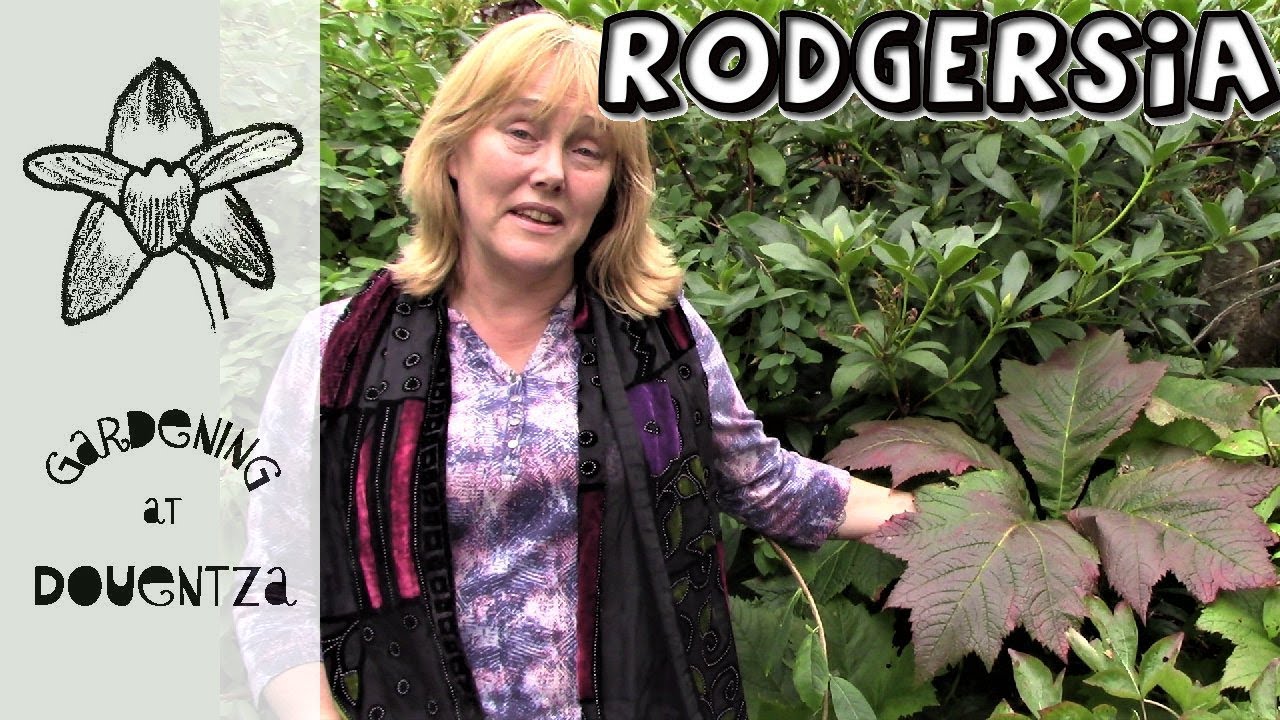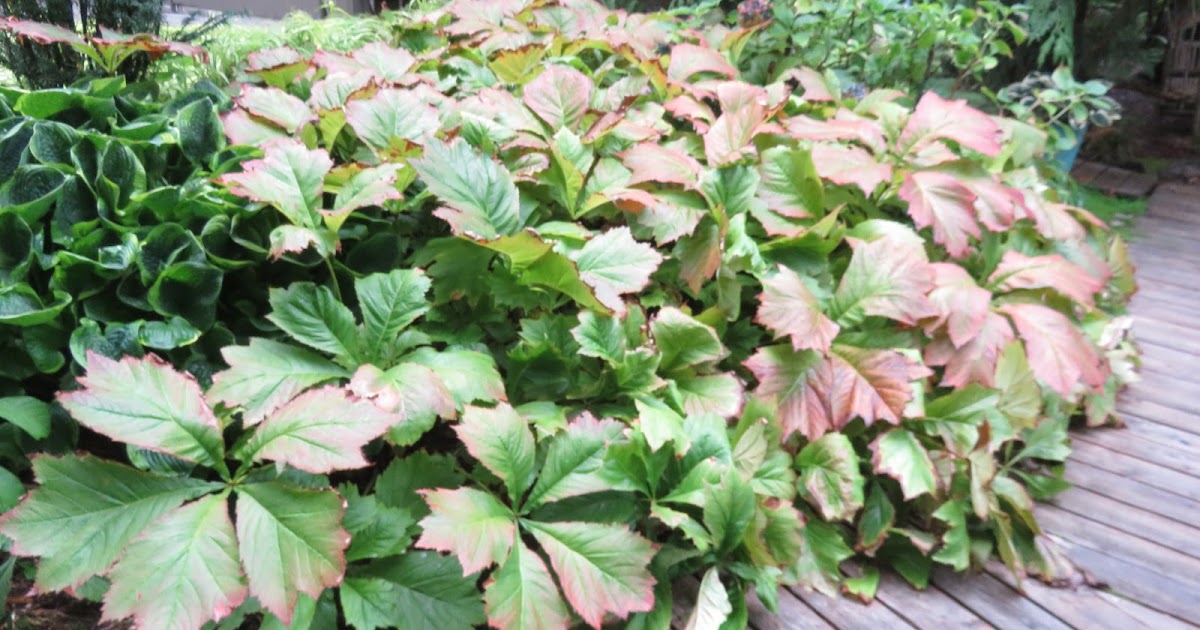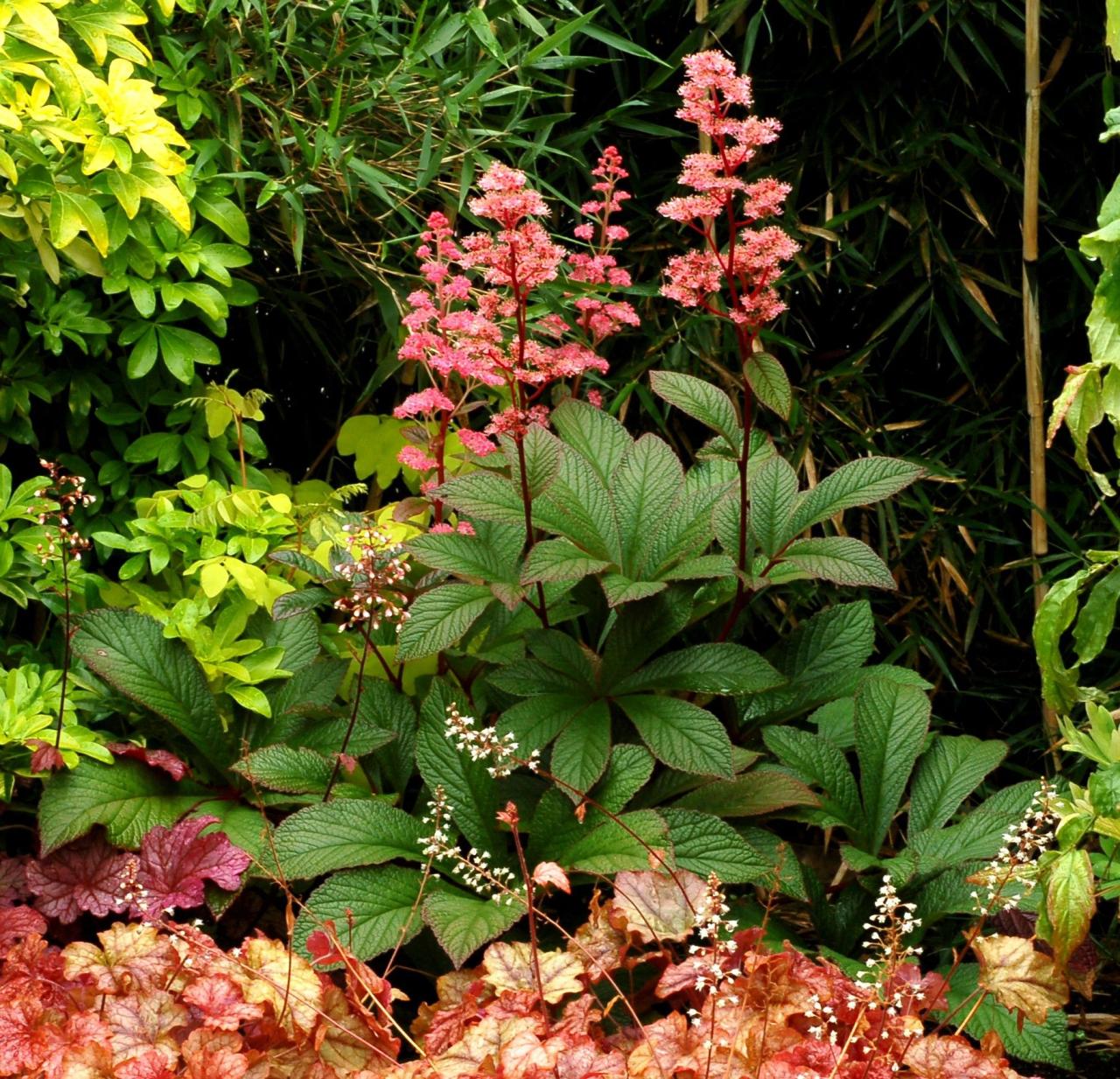The Top Secrets for Growing Beautiful Rodgers Plants – The Top Secrets for Growing Beautiful Rodgersia Plants unlocks the secrets to cultivating these magnificent plants, revealing a world of vibrant foliage and captivating beauty. Rodgersia, with its large, intricately-shaped leaves, offers a unique charm to any garden. This guide delves into the essential aspects of growing Rodgersia, from understanding their needs to mastering their care and propagation.
From selecting the right location and soil to understanding the optimal watering and fertilization techniques, this comprehensive guide will equip you with the knowledge to cultivate thriving Rodgersia plants. Discover the various Rodgersia varieties, their distinctive characteristics, and how to incorporate them seamlessly into your landscape design.
Understanding Rodgersia Plants
Rodgersia plants, members of the Saxifragaceae family, are captivating perennials known for their striking foliage and elegant flower stalks. These plants, native to East Asia, bring a touch of exotic beauty to gardens, adding a unique visual appeal with their large, deeply lobed leaves and graceful flower clusters.
Varieties of Rodgersia, The Top Secrets for Growing Beautiful Rodgers Plants
Rodgersia plants boast a diverse range of varieties, each possessing distinct characteristics that enhance their aesthetic appeal and adaptability to different garden settings.
- Rodgersia aesculifolia:This variety, commonly known as the “horse chestnut-leaved rodgersia,” showcases large, palmate leaves resembling those of the horse chestnut tree. These leaves, reaching up to 18 inches in diameter, are a stunning display of deep green, turning bronze in autumn.
- Rodgersia podophylla:This variety is recognized for its smaller, deeply lobed leaves with a prominent central lobe. The leaves are a vibrant green, contrasting beautifully with the creamy white flower clusters that emerge in late spring or early summer.
- Rodgersia sambucifolia:This variety, often called the “elder-leaved rodgersia,” features large, compound leaves resembling those of elderberry bushes. The leaves are a rich green, turning a deep burgundy in autumn.
- Rodgersia pinnata:This variety stands out with its pinnate leaves, composed of multiple leaflets arranged along a central stalk. The leaves are a deep green, becoming bronze-red in autumn.
Natural Habitats and Growing Conditions
Rodgersia plants thrive in moist, shady environments, mirroring their natural habitats in the mountainous regions of East Asia. They prefer rich, well-drained soils with a slightly acidic pH.
Unlocking the secrets to cultivating stunning Rodgers plants begins with understanding their unique needs. From choosing the perfect location to mastering the art of propagation, there’s a wealth of knowledge to be gained. For a comprehensive guide that covers everything from soil selection to pest control, check out Rodgers Plant: Essential Tips for Every Gardener.
With the right techniques and care, your Rodgers plants will thrive and reward you with vibrant foliage and beautiful blooms.
These plants can tolerate partial shade but perform best in dappled shade, where they receive a few hours of direct sunlight in the morning.
Rodgersia plants are relatively low-maintenance, requiring minimal care once established. Regular watering, especially during dry periods, is crucial for their optimal growth.
Ideal Growing Conditions

Rodgersia plants thrive in specific growing conditions that mimic their natural habitat. Understanding these preferences ensures optimal growth, vibrant foliage, and a healthy plant.
Light Requirements
Rodgersia plants prefer dappled shade or partial shade. Direct sunlight can scorch their leaves, leading to browning and wilting. The ideal location is under the canopy of deciduous trees, providing filtered sunlight during the day and full shade in the afternoon.
Soil Type and pH
Rodgersia plants prefer rich, moist, and well-drained soil. A slightly acidic to neutral pH, ranging from 6.0 to 7.0, is ideal. The soil should be fertile and contain ample organic matter, which helps retain moisture and provides essential nutrients.
Watering Schedule
Rodgersia plants are moisture-loving and require consistent watering, especially during dry periods. The soil should be kept consistently moist but not waterlogged.
Watering frequency depends on factors like weather, soil type, and pot size.
During the growing season, water deeply once or twice a week, ensuring the water reaches the roots. In the winter, reduce watering as the plant enters dormancy.
Planting and Propagation
Rodgersia plants are relatively easy to establish and propagate, making them a rewarding addition to any garden. Whether you’re starting from seed or dividing existing plants, understanding the optimal techniques ensures successful growth and vibrant foliage.
The Top Secrets for Growing Beautiful Rodgers Plants are all about providing the right conditions for these stunning plants to thrive. From understanding their preferred soil and light requirements to knowing when and how to prune, there’s a lot to learn.
To truly create a thriving oasis for your Rodgers plants, consider reading our guide on How to Create a Thriving Rodgers Plant Oasis. Once you’ve mastered these techniques, you’ll be well on your way to growing healthy, vibrant Rodgers plants that will be the envy of your neighborhood.
Planting Rodgersia
Planting Rodgersia is best done in early spring or late summer, allowing the plants ample time to establish roots before winter. Choose a location with partial shade to full shade, as direct sunlight can scorch the leaves. The soil should be moist, well-drained, and rich in organic matter.
- Dig a hole twice the width and depth of the root ball.
- Amend the soil with compost or other organic matter to improve drainage and fertility.
- Place the plant in the hole, ensuring the crown is at or slightly above soil level.
- Backfill the hole with soil, gently firming it around the roots.
- Water thoroughly to settle the soil and encourage root growth.
Propagating Rodgersia
Rodgersia can be easily propagated by division, which involves separating established clumps into individual plants. This method is ideal for creating new plants or refreshing existing ones.
- Divide Rodgersia plants in early spring or late summer, when the plants are actively growing.
- Use a sharp, clean spade or knife to carefully separate the clump into individual plants.
- Each division should have at least one healthy bud or growth point.
- Plant the divisions in prepared beds, following the same planting instructions as for new plants.
- Water thoroughly and provide shade during the initial establishment period.
Selecting Healthy Rodgersia Plants
When purchasing Rodgersia plants from nurseries or seed sources, it’s crucial to choose healthy specimens that will thrive in your garden.
- Look for plants with vibrant green foliage, free from pests and diseases.
- Inspect the roots for any signs of damage or rot.
- Choose plants that have been grown in a similar climate and soil conditions to your garden.
- Consider purchasing plants from reputable nurseries or seed sources that offer guarantees or warranties.
Care and Maintenance

Rodgersia plants are generally low-maintenance and require minimal care once established. However, providing them with the right conditions can help them thrive and produce stunning foliage. Here are some essential care and maintenance practices to ensure the health and beauty of your Rodgersia plants.
Fertilization Requirements
Rodgersia plants benefit from regular fertilization, particularly during their active growth period in spring and early summer. Fertilizing provides essential nutrients for healthy growth and vibrant foliage.
- Apply a balanced granular fertilizer, such as a 10-10-10 formulation, around the base of the plant in early spring.
- Follow the instructions on the fertilizer packaging for application rates and frequency.
- Avoid over-fertilizing, as it can lead to excessive foliage growth at the expense of flowering.
Mulching
Mulching plays a crucial role in maintaining healthy Rodgersia plants by:
- Conserving soil moisture: Mulch acts as a barrier, preventing moisture evaporation from the soil, especially during dry periods.
- Moderating soil temperature: Mulch helps insulate the soil, protecting roots from extreme heat and cold fluctuations.
- Suppressing weeds: Mulch effectively prevents weed growth, reducing competition for nutrients and water.
- Enhancing soil fertility: As mulch decomposes, it releases beneficial nutrients into the soil, improving overall soil fertility.
Apply a 2-3 inch layer of organic mulch, such as wood chips, shredded bark, or compost, around the base of the plant, keeping it away from the stems to prevent rot.
Pruning
Pruning Rodgersia plants is generally not necessary, as they have an attractive natural form. However, removing dead or damaged foliage can enhance the plant’s appearance and promote healthy growth.
- Prune any dead or damaged leaves in late fall or early spring before new growth emerges.
- Use sharp, clean pruning shears to make clean cuts just above a leaf node or at the base of the stem.
- Remove any flower stalks after flowering to prevent the plant from expending energy on seed production.
Pest and Disease Management: The Top Secrets For Growing Beautiful Rodgers Plants
Rodgersia plants are generally robust and resistant to common pests and diseases, but occasional issues may arise. Understanding the potential threats and implementing preventive measures can help maintain the health and vigor of your Rodgersia.
Common Pests
Rodgersia plants are not typically targeted by many pests. However, a few insects may occasionally cause problems.
- Aphids: These small, soft-bodied insects can suck sap from leaves, causing distortion and yellowing. Aphids can be controlled by spraying with insecticidal soap or a strong jet of water.
- Slugs and Snails: These mollusks can damage foliage by leaving holes and slime trails. Hand-picking or using a copper barrier around the plant can deter them.
- Leafhoppers: These insects feed on the underside of leaves, causing stippling and yellowing. Insecticidal soap can be used to control leafhoppers.
Preventing and Controlling Pest Infestations
Preventing pest infestations is crucial for maintaining healthy Rodgersia plants.
- Regular Inspection: Regularly inspect your plants for signs of pests, such as holes in leaves, discolored areas, or insect activity. Early detection allows for prompt action.
- Maintaining Healthy Plants: Strong, healthy plants are better equipped to withstand pest attacks. Provide adequate water, nutrients, and sunlight to promote vigorous growth.
- Natural Predators: Encourage beneficial insects, such as ladybugs and lacewings, that prey on pests. These natural predators can help control pest populations.
Potential Diseases
Rodgersia plants are generally resistant to diseases, but a few fungal infections can occur.
- Powdery Mildew: This fungal disease appears as a white, powdery coating on leaves. Good air circulation and avoiding overhead watering can help prevent powdery mildew.
- Leaf Spot: This fungal disease causes brown or black spots on leaves. Removing infected leaves and providing adequate drainage can help control leaf spot.
- Root Rot: This fungal disease occurs in poorly drained soil and can cause wilting and yellowing of leaves. Avoid overwatering and ensure good drainage.
Solutions for Disease Management
- Fungicides: For severe fungal infections, fungicides can be used to control the disease. Follow the instructions on the product label carefully.
- Cultural Practices: Implementing proper cultural practices, such as avoiding overhead watering, providing good air circulation, and maintaining healthy soil, can help prevent disease outbreaks.
Rodgersia in Landscape Design
Rodgersia plants, with their striking foliage and graceful flower stalks, are a valuable addition to any garden design. Their versatility allows them to be incorporated in various ways, creating a dramatic and textural presence.
Incorporating Rodgersia into Garden Designs
The following table illustrates different ways to use Rodgersia in garden designs, highlighting their adaptability and aesthetic appeal:
Design Idea |
Rodgersia Variety |
Planting Location |
Additional Notes |
|---|---|---|---|
Focal Point in a Shade Garden |
Rodgersia podophylla ‘Superba’ |
Center of a shaded border |
Its large, deeply lobed leaves create a dramatic focal point. |
Mass Planting for Textural Contrast |
Rodgersia aesculifolia |
Along a woodland edge or stream |
The bold foliage creates a striking contrast against the backdrop of trees. |
Companion Planting with Ferns |
Rodgersia sambucifolia |
Underneath deciduous trees |
Their shared preference for shade and moisture makes them ideal companions. |
Border Edging for a Naturalistic Look |
Rodgersia pinnata ‘Chocolate Wings’ |
Along a path or walkway |
The dark, burgundy foliage adds a touch of elegance to the border. |
Designing a Sample Landscape Plan
Imagine a woodland garden setting with a meandering stream. The stream bank is planted with a mass of Rodgersia aesculifolia, their large, deeply lobed leaves creating a lush and textured backdrop. At the edge of the stream, a group of Rodgersia podophylla‘Superba’ stands tall, their large, deeply lobed leaves providing a striking focal point.
The space beneath the trees is planted with a variety of ferns, their delicate fronds complementing the bold foliage of the Rodgersia. This combination of plants creates a beautiful and harmonious landscape, showcasing the versatility and aesthetic appeal of Rodgersia.
Benefits of Using Rodgersia as a Focal Point or Backdrop
Rodgersia plants excel as focal points in shade gardens due to their large, bold foliage and graceful flower stalks. Their striking presence draws the eye and creates a sense of drama. Alternatively, Rodgersia can be used as a backdrop for other plants, providing a lush and textured background that enhances the beauty of the surrounding plants.
For instance, the delicate blooms of hostas or the vibrant colors of begonias are beautifully showcased against the backdrop of Rodgersia foliage.
Inspiration and Examples

Rodgersia plants are renowned for their dramatic foliage and graceful presence in the garden. Their large, palmate leaves and striking flower stalks create a captivating spectacle, adding a touch of elegance and grandeur to any landscape. To inspire your own garden designs, let’s delve into the beauty of Rodgersia plants in different settings.
Rodgersia in a Woodland Garden
Imagine a serene woodland garden bathed in dappled sunlight, where the air is filled with the scent of wildflowers. In this tranquil setting, Rodgersia plants thrive, their lush foliage creating a verdant canopy that welcomes shade-loving companions. The vibrant green leaves of Rodgersia ‘Chocolate Wings’ contrast beautifully with the delicate white blooms of ferns, while the bronze hues of Rodgersia ‘Purple Emperor’ add a touch of autumnal splendor.
The combination of these plants creates a harmonious symphony of textures and colors that evoke a sense of peace and tranquility.
Rodgersia as a Focal Point
Rodgersia plants can be used as a focal point in a garden, drawing the eye to their majestic presence. Their large, bold leaves create a striking visual impact, especially when planted in a prominent location. The dramatic flower stalks of Rodgersia ‘Superba’ rise above the foliage, creating a vertical element that adds dimension and intrigue.
A single plant can serve as a captivating centerpiece in a small garden, while a group of Rodgersia plants can create a breathtaking display in a larger landscape.
Rodgersia in a Water Garden
Rodgersia plants are well-suited for water gardens, where they thrive in moist, fertile conditions. Their lush foliage creates a stunning backdrop for water lilies and other aquatic plants, while their graceful flower stalks add a touch of elegance to the water’s edge.
The combination of Rodgersia plants with water features creates a serene and inviting atmosphere, reminiscent of a tranquil oasis.
Closing Summary
By embracing these secrets, you can unlock the potential of Rodgersia plants, transforming your garden into a sanctuary of captivating beauty. With a little care and attention, these striking plants will flourish, rewarding you with their vibrant foliage and captivating presence.
Let your garden become a testament to the art of cultivating these unique and captivating plants.
General Inquiries
What are the most popular Rodgersia varieties for beginners?
Rodgersia pinnata, Rodgersia podophylla, and Rodgersia aesculifolia are popular choices for beginners due to their adaptability and striking foliage.
Can I grow Rodgersia in containers?
Yes, Rodgersia can be grown in containers, but they require a large pot with adequate drainage and moisture-retentive soil.
How often should I fertilize Rodgersia plants?
Fertilize Rodgersia plants in spring with a balanced fertilizer, and you can repeat this process once or twice during the growing season.
